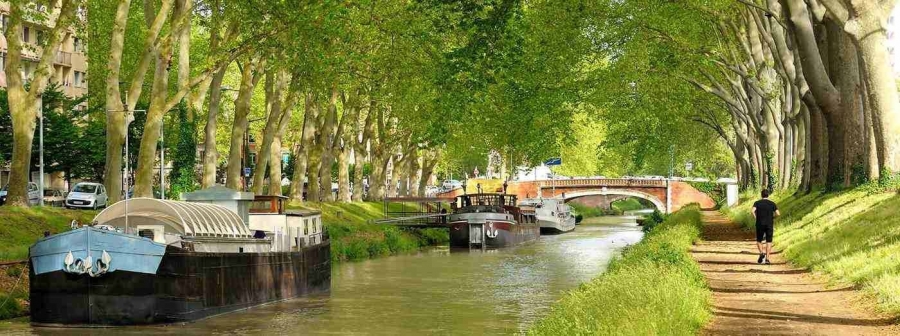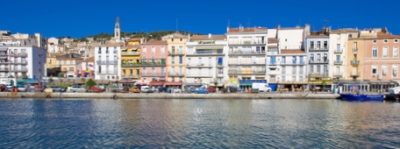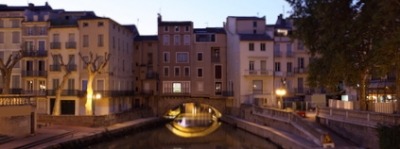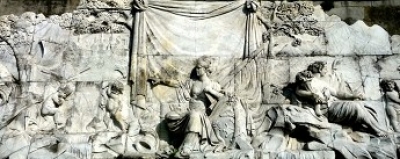World Heritage
In 1994, the Voies Navigables de France (Waterways of France), which manages the canal, presented a proposal to classify the Canal du Midi as a World Heritage Site. The regions of Languedoc-Roussillon and Midi-Pyrénées subsequently submitted its candidacy to the World Heritage List in June 1995.
UNESCO accepted its candidature on December 6, 1996 for the classification of the Canal du Midi. Registered under this heritage site is the initial work of Pierre-Paul Riquet: the canal between Toulouse and the Etang de Thau, the watershed point in Naurouze and its supply system, as well as all works dating from this early period. The collection system of the sources of the canal in the Montagne Noire (Black Mountain), the Canal de Jonction, the Canal de la Robine and the Canal de Brienne in Toulouse were also included in the scope.
“The Committee decided to include the nominated property on the basis of cultural criteria (i), (ii), (iv) and (vi) considering that the site is of outstanding universal value being one of the greatest engineering achievements of the Modern Age, providing the model for the flowering of technology that led directly to the Industrial Revolution and the modern technological age. Additionally, it combines with its technological innovation a concern for high aesthetic architectural and landscape design that has few parallels elsewhere.”
Criteria for Selection
Criterion (i): The Canal du Midi is a living example of the creativity of engineers of the time of Louis XIV, which marked the shift from the Renaissance to the modern period in terms of development of construction techniques. For this reason, the canal is known as a kind of inauguration of the modern era of the development of inland waterway networks in the industrialized countries of Europe and North America. The genius of this work is manifested in various aspects of the design and construction of the Canal du Midi, in studies of water supply networks, organization of construction work and the constant modification of the project to meet the realities on the ground.
Criterion (ii): The construction of the Canal du Midi is simply the largest public works project in Europe since the end of the Roman Empire. The work was conducted in a constant search for perfection. Its achievement is all the more remarkable because for the first time on this large scale, the contractor and engineers sought to shape the landscape and vegetation to become a source of visual enchantment, an example worthy of the linear planning masterpieces of the Roman Empire. The canal inspired many famous men of the time who visited while under construction or after its completion, such as the Prince of Denmark and Thomas Jefferson, future President of the United States of America.
Criterion (iv): The canal is the symbol of an era of prosperity in which engineers and entrepreneurs endeavored, for the glory of the Sun King (Louis XIV), to bring together art and function. The canal was principally used for transportation and irrigation of agricultural land, but its builders wanted to create works that conveyed a sense of overall harmony. The canal generated social, technological and architectural progress, and while implemented efficiently, managed to maintain an artistic aspect in its overall composition. The canal also represents a significant period of European history, from maritime transport to hydraulic engineering. This period began at the time of the Italian Renaissance and continued until the industrial revolution and the arrival of the railway.
Criterion (vi): The construction of the Canal du Midi has become the most important element of the landscape it crossed. Perfectly integrated in its environment, it delicately molded the surrounding landscapes.
Source : UNESCO / ICOMOS
History
History of the Canal du Midi
The project
Since ancient times many projects of this type had existed. The possibility of connecting the Mediterranean Sea and the Atlantic Ocean was an opportunity to develop trade, and avoid the (long) circumvention of Spain, rife with piracy, around the Strait of Gibraltar. But no project had ever been possible, because no one had figured out how to answer the question of perennial water supply.
It was Pierre-Paul Riquet who found the solution to this problem. In 1662, he imagined the diversion of many courses of rivers to feed the canal at the watershed between the Atlantic and the Mediterranean, with Naurouze identified as the high point. This was the threshold of the watershed. From the summit, 189 meters high, the waters from the Montagne Noire run eastward towards Béziers and the Mediterranean, and westward towards Toulouse and the Atlantic. To regularly feed the canal, and cope with climate hazards (rainfall deficiencies in summer and excess in winter), Riquet created a basin to store water, now known as Lac de Saint Ferréol (Saint Ferréol Lake), created by a dam, which was the first in the world to be built specifically to supply water to a canal.
Construction : a visionary and hierarchical social organization
Far ahead of his time, Riquet set up a hierarchical organization of 200 workers, divided into workshops and teams of 40 to 50 people led by the foremen themselves, and supervised by inspectors. At the time the financial and social conditions of the employment of workers were very favorable and unusual: the workers were better paid than for other trades (the salary was double that of a farm laborer). Age was limited to between 20 and 50 years. Rainy days were general holidays, and work on public holidays and Sundays were paid, as was sick leave. Even housing was made available to workers at a modest price. This secure social policy allowed Riquet to complete the work in record time for the technical means of the era. The project officially lasted 14 years (1667-1681), although many additional works took place until 1694 for official completion.
Initially, 2,000 workers were involved in 1667, though at the peak of construction there were nearly 12,000 at work on the sites, and as many women as men. Many tradesmen worked together. Bricklayers and stonemasons were responsible for the construction of civil engineering structures (bridges, locks, siphons). Blacksmiths and levelers were responsible for the maintenance of the equipment. Agricultural workers were involved in leveling and transporting the earth. Carters and carriers, blacksmiths and owners of mills were themselves requisitioned as needed.
Merchandise transport
Ever since its implementation, the Canal du Midi has been used to transport goods (wheat, wine ...), passengers (100,000 passengers in 1856) and mail. Like for coaches, boats were pulled by horses on towpaths. It took four days to go between Sète and Toulouse. During the two centuries that followed its construction, the Canal du Midi experienced its heyday, but the arrival of rail lines and road transport during the 20th century would provide ample competition. The last freight barges to take the Canal du Midi were in the 1980s. It is now exclusively dedicated to tourism.
Excerpts of the Canal du Midi Regulations (early 19th century)
"Any manager who ships goods, foodstuffs and other items on the canal must declare the quantity, quality, weight, brand, number and designation of bales, barrels, crates and other receptacles that are loaded."
"The levying of navigation fees will be based on the gross weight of the goods."
"Every manager shall be obliged to stop with his boat in front of each office of the canal to take the passage ticket and declare any goods taken on board since the last office ..."
"Navigation fees must be paid within three days of unloading of the goods ...."
Cultural Landscapes
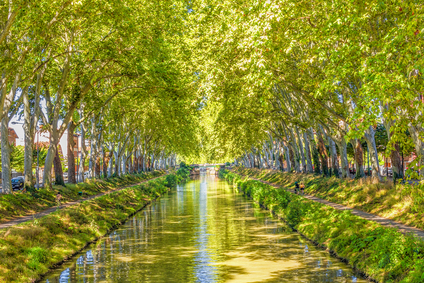
Landscapes of the Canal du Midi
The Canal du Midi has had a strong impact on the organization of landscapes in its environment, but it is also a landscape in itself, thanks to the trees that line the water. Strategic planting of vegetation began in the 18th century, its goal to stabilize the banks with roots, and provide shade – useful for past and present travelers and for fighting against the evaporation of water. It was later that these additions would be perceived as an element for visual embellishment.
In the mid-19th century, a large planting campaign of plane trees gave the canal the esthetic we know today. Other species of trees (poplar, ash, cypress, pine ...) also form bucolic aisles that change colors with the seasons.
Canker Stain disease
The plane trees along the Canal du Midi are victims of a fungus that lodges itself inside the shaft and kills the tree within 5 years. Removal is the only solution to minimize contamination because the disease spreads very quickly, and no phytosanitary solution is possible.
Eventually, the 40,000 plane trees of the canal will be threatened by the disease and will need to be replaced. And so in 2011, a program for replanting trees on the Canal du Midi was launched. This program is a long-term project that will allow to reconstruct the image of the Canal du Midi for future generations, all the while contributing to the preservation of biodiversity.
Towpaths
These paths along the canal on the bank were used by horses that pulled (towed) barges. They are mainly used today for walking. In some places, horse-hauling was put back in place for barge rides.
Water features
The Canal du Midi has 126 bridges, 64 locks (33 of which are manual), 55 aqueducts, 7 navigable aqueducts, 6 dams and 1 tunnel. In total, it consists of 328 elements, including the catchment and the Canal de la Robine.
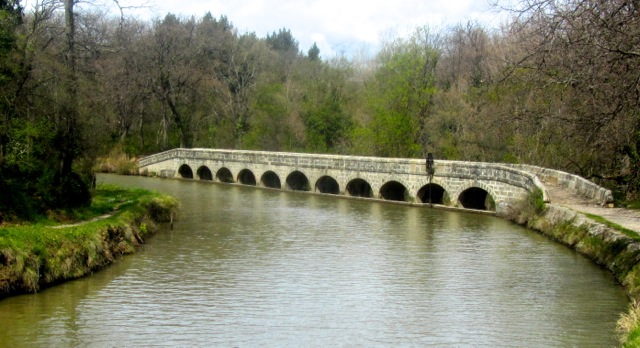
Weirs and Siphons
To prevent flooding of the canal, siphons and weirs were put into place to drain excess water that may raise the level during severe storms or flooding of nearby rivers.
Weir: evacuates excess water from the surface of the water. When the level is too high, water will run to where the level is the lowest on the river that lies below.
Siphon: allows the removal of excess water by opening a valve (manual or automatic) at the bottom of the canal.
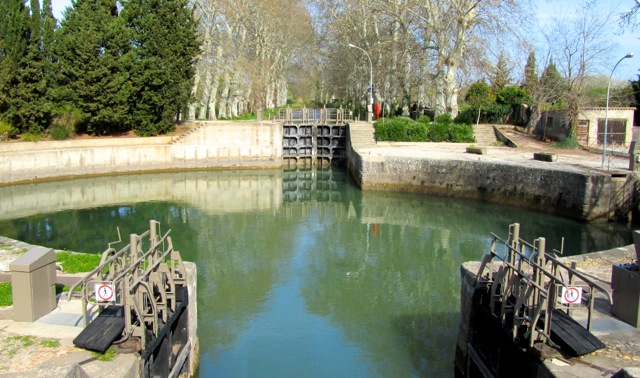
Locks
The locks on the canal respond to the need to cross natural gradients, to "descend" (from Naurouze to Agde), to "climb" (in reverse) and to go from one reach (level) to another and vice versa. The locks on the Canal du Midi are oval, which distributes the pressure exerted by the water in the basin to its walls. They are built of stone and sealed with lime. Two doors, provided with movable gates, close the lock on each side. Depending on the distance down to the next level, they may be numerous.
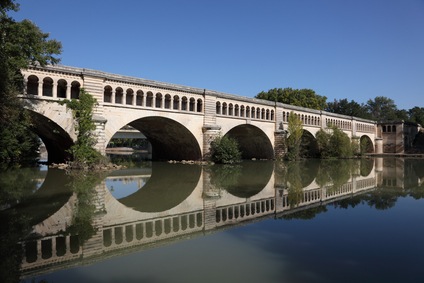
Navigable aqueducts
To avoid an overflow when a nearby river floods, Riquet chose to implement the construction of navigable aqueducts, a first in Europe. The canal passes over a bridge, which is itself over the river. The Répudre aqueduct is the only one that was originally built by Riquet, but 49 others were built later, mostly by Vauban.
Water supply
A water tank fed by the Rigole (channel) de la Montagne, irrigated by the streams of the Montagne Noire, was created in Saint Ferréol. From Saint Ferréol, water travels 34 kilometers using the Rigole de la Plaine, emptying into the octagonal basin in Naurouze. This is the main source of the canal, though other intakes are positioned along the way.
Pierre Paul Riquet
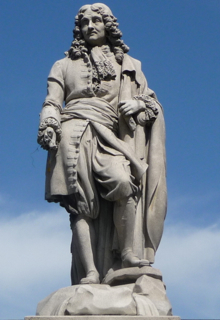
Pierre Paul RIquet, a genius of his time
Originally from Béziers, Pierre Paul Riquet lived in Revel from 1648 to 1660. This is where the project would be born. He roamed all along the Montagne Noire to find enough water to supply a canal on both sides. It is thanks to him that the canal meets the criterion (i) for the World Heritage designation by UNESCO. The Canal du Midi is indeed the work of genius human creator.
His life, his work
1609 : alleged birth of Pierre-Paul Riquet in Béziers.
1630 : Riquet becomes the Gabelle (salt tax) Controller of Languedoc.
164 8: R iquet moved to Revel at the foot of the Montagne Noire.
1662: Riquet presents his maritime canal project to Colbert.
May 1665: Riquet is allowed to dig a test trench to verify whether it is possible to get enough water to Naurouze.
October 1665: The test channel is completed, and is a total success.
July 1666: Laying of the foundation stone at the port of Sète.
October 1666: Louis XIV signed the "Edict of construction for the canal for the Atlantic Ocean and Mediterranean Sea."
1667: Start of construction. Several projects are launched simultaneously.
1668: Riquet becomes "Lord of the Canal du Languedoc". He would then receive all revenue from taxes on the transportation of goods and people.
."Legend says that one day, while he was exploring the region of Naurouze, a large stone from the hill formed a mini-dam on a stream. Riquet noticed that the waters separated into two streams, one flowing to the Mediterranean and the other to the Atlantic. The idea to create a water reservoir that would feed both sides of the canal was born. "
October 1, 1680 : Riquet dies. His eldest son, would continue the site.
May 15 to 25, 1681: Impoundment complete for the canal. Navigation begins between Toulouse and Sète.
1686: King Louis XIV sends Vauban, Commissioner General of Fortifications of the Kingdom, to inspect the canal. The latter would advocate the construction of multiple structures to minimize siltation of the canal. This work would be carried out from 1687 to 1694.
1782: Opening of the Canal de la Robine in Narbonne.
1810: The canal passes through Carcassonne.
1838 to 1856: The canal lateral to the Garonne River is built between Toulouse and Castets-en-Dorthe in Gironde (193 km).
The VNF
Voies Navigables de France
Website - Emanation of the French State, the Voies Navigables de France (Waterways of France) is a Public Establishment for Commercial Interest created in 1991. It manages all the canals in France.
VNF Objectives
-
Manage, maintain and operate 6,700 kilometers of rivers and canals, more than 3,000 water features and 40,000 hectares of public domain bordering the waterways.>
-
Develop river transport and related activities.
-
Put into place a policy of development of the waterways and of their usage
-
Participate in the sustainable development of territories.
-
Promote the implantation of industrial and logistics spaces, as well as the development of tourism.
-
The lock keepers represent a staff of 350 members, working year-round to operate the canal. They are employees of the Ministry of Equipment who are made available to the VNF.
Regional Directorate Toulouse
2 Port Saint Etienne,
31000 Toulouse
Tel: 05 61 36 24 24.
VNF Béziers
Avenue du Prado, 34500 Béziers
Tel: 04 67 11 81 30.
VNF Carcassonne
Port du Canal, 11000 Carcassonne
Tel: 04 68 71 74 55
.
Transport
Getting to the Canal du Midi
The Canal du Midi runs through three major cities: Béziers, Carcassonne and Toulouse.
Getting to Béziers
By car
Highway A9 from Montpellier or Carcassonne.
Highway A75 from the Causse du Larzac (WH site Causses and Cévennes). In the direction of the Gare SNCF (train station)
Nearby classified sites:
Medieval city of Carcassonne: 90 km (56 mi), time: 1 hour, 5 minutes
Causses and Cévennes (La Couvertoirade): 85 km, (53 mi) time: 1 hour, 5 minutes
Pont du Gard: 145 km (90 mi), time: 1 hour, 25 minutes
Arles: 145 km (90 mi), time: 1 hour, 35 minutes
By Plane
Montpellier Méditérranée Airport
34130 Mauguio
Website - Tel: 04 67 20 85 00.
Distance from Béziers: 76 km (47 mi), time: 50 minutes by car.
By train
Gare SNCF
14 Boulevard de Verdun, 34500 Béziers
Website - Tel: 36 35.
Getting to Carcassonne
By car
Highway A61 or RN 113 from Beziers or from Toulouse.
Nearby classified sites
Medieval city of Carcassonne: 0 km (in the city)
Causses and Cévennes (La Couvertoirade) 172 km (107 mi), time: 1 hour, 50 minutes
Albi : 166 km (103 mi), time: 1 hour, 50 minutes
By Plane
Carcassonne Airport
Route de Montréal, 11000 Carcassonne
Website - Tel: 08 20 67 34 11.
Many international connections via Ryanair. Shuttle to the city center (€6). Price includes 1 hour of public transport access
By Train
Gare SNCF
1 Avenue du Maréchal Joffre, 11000 Carcassonne
Website - Tel: 36 35.
Getting to Toulouse
By car
Highway A61 (from Bordeaux, Saint Emilion or Vallée de la Vézère).
Highway A62 (from Carcassonne).
Highway A64 (from Gavarnie-Mont Perdu).
Nearby classified sites:
Medieval city of Carcassonne: 94 km (58 mi), time: 1 hour, 15 minutes
Episcopal City of Albi: 76 km (47 mi), time: 1 hour, 10 minutes
Gavarnie - Mont Perdu: 220 km (137 mi), time: 3 hours
Bordeaux - Port of the Moon: 245 km (152 mi), time: 2 hours, 45 minutes
Vallée de la Vézère: 200 km (124 mi), time: 3 hours
By Plane
Toulouse Airport
31700 Blagnac
Website - Tel: 08 25 38 00 00.
Tramway to the city center.
By train
Gare SNCF
80 Boulevard Pierre Semard, 31000 Toulouse
Website - Tel: 36 35.
Traveling on the Canal du Midi
Several options are available for visitors who wish to discover the Canal du Midi. It is possible to follow the banks through picturesque landscapes, by bike or on foot, in one or more stages. But it is without a doubt navigating the waters of the canal that best allows its discovery. Different packages are available, by the hour or for the week.
The Canal du Midi by boat
Periods of navigation: The locks are open daily from mid-March to early November except on May 1st, July 14th and November 1st. If you rent a boat, lock passage is included in the rental.
The opening hours of locks
March : 8 a.m. to 12:30/ 1:30 p.m. to 5:30 p.m.
April: 8 a.m. to 12:30/ 1:30 p.m. to 6:30 p.m.
May: 8 a.m. to 12:30/ 1:30 p.m. to 7 p.m.
June, July and August: 8 a.m. to 12:30/ 1:30 p.m. to 7:30 p.m.
September: 8 a.m. to 12:30/ 1:30 p.m. to 6:30 p.m.
October: 8 a.m. to 12:30/ 1:30 p.m. to 6 p.m.
The different options
River cruises allow visitors to discover the charms and advantages of navigation, the beauty and the richness of the regions.
• Cruises organized by half-day or full day
• Hotel barges (food and lodging included), the most expensive package,
• Barge trips,
• Rent a houseboat or a boat, from one day to one week,
• Rent a boat by the hour or by half-day.
Boat rental
The houseboats are fully-equipped, like a floating apartment. Ideal for families, rentals are available by the day or by the week. They require no special license. Charter boat companies are not present in all ports.
Packages are based on the company’s presence at certain points along the canal. In addition, depending on the package chosen, the journey could be a one-way (transfer vehicle may be possible, please ask the owner) or a return trip (though it may be less interesting for travelers to revisit the sites). Supplies can easily be obtained along the way; visitors can find all shops and services in the villages that dot the course of the canal.
Rental companies always provide a statement the day of departure to familiarize visitors with boat handling, though overall navigation is easy. There must be at least two people to perform maneuvers during lock crossing.
Major rental companies on the Canal du Midi
Locaboat
Website - tel: 03 86 91 72 72
Present in Argens-Minervois and Négra.
Les Canalous
Website - tel: 03 85 53 76 74
Present in Colombiers, Agde, Homps and Carcassonne.
Le Boat
Website - tel: 04 68 94 42 80
Present in Narbonne, Port Cassafières (Portiragnes), Homps, Trèbes, Castelnaudary.
Nicols
Website - tel: 02 41 56 46 56
Present in Port Lauragais (Avignonet-Lauragais) and Le Somail.
Cycling along the Canal du Midi
It is possible to travel the 240 kilometers between the Mediterranean Sea and Toulouse by bicycle, via:
• the “voie verte”, exclusively reserved for pedestrians and non-motorized vehicles,
• the towpath, located along the bank of the canal,
• the bikeway, small bike path near the canal.
Equipment: A mountain bike is recommended.
Supplies: as for canal navigation, refueling is no problem, as many villages along the way offer shops and other services.
Traveling by bike with the SNCF
The SNCF has set up a website dedicated to people who wish to travel with their bikes on its train lines. A handy tool if you want to cycle along the canal (from station to station) and use this means of transport for the return journey. You can also send your bike from any station and receive it on the spot. All information is available on the website. The site also details a selection of bike rental companies.

